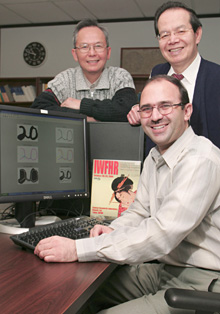The writing is on the wall

Professors Tien Bui and Ching Suen, with Javad Sadri in front.
Photo by Andrew Dobrowolskyj
Does your handwritten number four have a break point? Does your seven have a European strike through it, or is it plain and straight?
Perhaps these dilemmas are not standard water-cooler talk, but for optical scanners and those who use them, it’s a million-dollar business. Computers that accurately read handwritten cheques and postal codes are a big deal.
That’s where CENPARMI comes in. It’s shorthand for Concordia’s Centre for Pattern Recognition and Machine Intelligence. Professor Ching Suen explained, “We try to make computers do what we do.”
Human creativity in handwriting has become a fairly predictive science. Since 1988, when Suen and his colleagues founded CENPARMI, pattern recognition has gone from 80-per-cent accuracy to more than 99-per-cent accuracy today.
Suen and his colleagues approach the decoding of handwriting like archaeologists, examining letters and numerals like fossils. This includes recognizing an average of 50,000 words per language and the many ways of saying similar things that some languages have. Some languages have as many as 10 different ways to express the same concept.
The team looks for the contour, gradient and aspect ratio of a number or letter. The number 3, which a computer can recognize by commonalities it will always find on the right, as well as the left, sides of the number. But now, when the scanner views a number 4, it can process breaks in what is usually a straight line.
“We have become more creative” about human handwriting. “So have computers.”
Suen explained that the cost of processing a computer-printed cheque can be as little as five cents, whereas the cost of processing a handwritten cheque can range up to five dollars if a person has to look at it.
The research centre recently hit a milestone of sorts as a CENPARMI group presented 14 papers (out of a total of 100) at the 9th International Workshop on Frontiers in Handwriting Recognition, held in Tokyo, Oct. 26 to 29.
Professors Ching Suen, Tien Bui, Mohamed Cheriet and Robert Sabourin led the group, which included their students Javad Sadri, Hanshen Tang, Alseo de S. Britto, Cesar Santos, Edson Justino, Allessandro Koerich, Jonathan Milgram, Marisa Morita, Luis Oliveira, Marcelo Kapp, Cinthia de A. Freitas.
The paper “Automatic segmentation of unconstrained handwritten numeral strings,” authored by Javad Sadri, Ching Suen and Tien Bui, received the Best Poster/Paper Award.